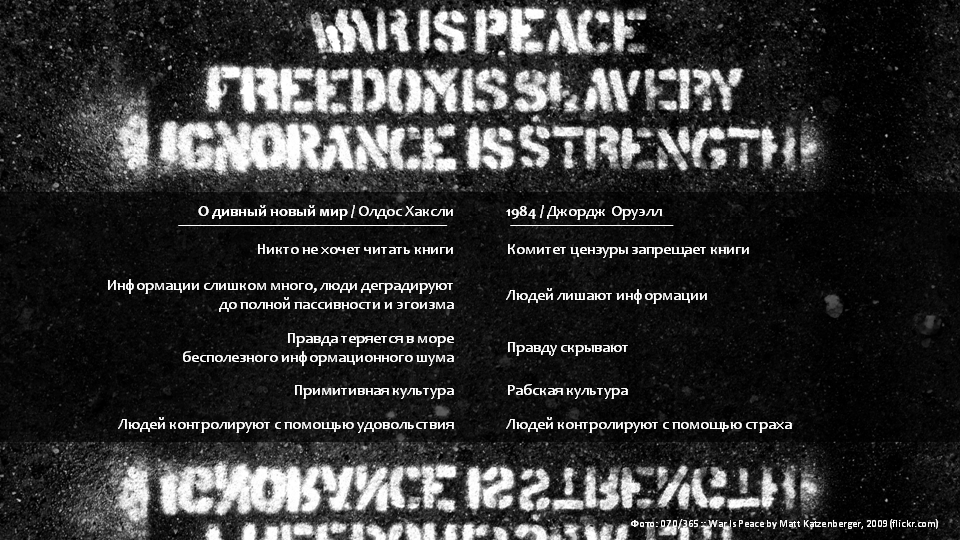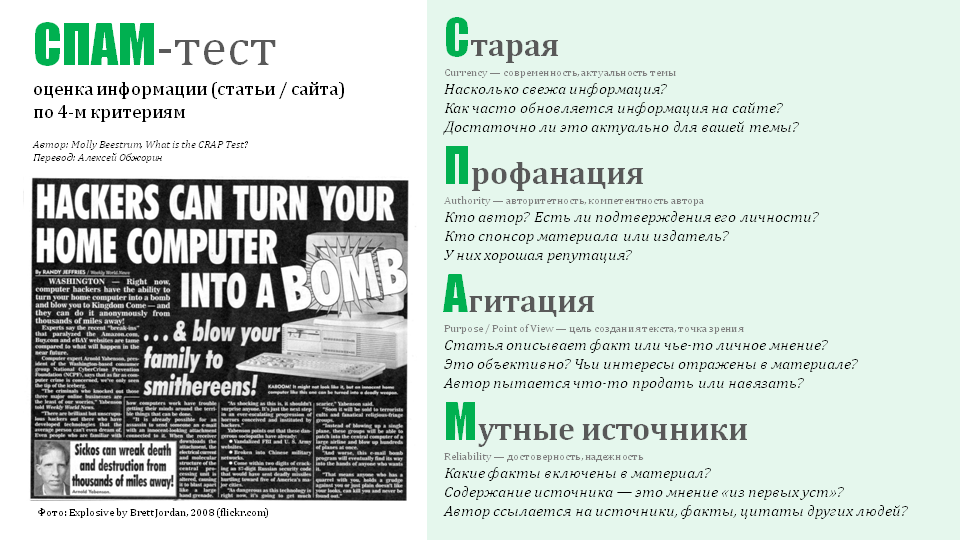"Automatic Spam Detector". Or "What were Hemingway, Huxley, and Postman warned about?"

Every person inside should have an integrated automatic shit detector ( Ernest Hemingway , 1954)On this day, almost fifty years ago, an unusual article was delivered to the National Convention for Teachers of English (Washington DC). Neil Postman , an American writer, educator, media theorist and cultural critic, raised the topic that the main task of teachers is to teach children to resist the influence of useless and false information.
November 28, 1969
Excerpt from the article:
I see it this way: the best thing schools can do for children is to teach them to distinguish useful information from useless information. I think that all serious people understand that about 90% of what they give in school is useless. I do not require the exclusion from the school courses of something important or meaningful. But even if that is the case, I will still insist that the main goal, superior to any other in education, should be “turning on the shit detector”. And this is due not only to the fact that it takes a lot of time. I say this because every day, wherever possible, we are confronted with so many delusions that it is difficult to sustain a healthy person - everyone agrees. And if we help children realize this, then they can avoid this empty information and pay attention to something really useful.
(Neil Postman, Bullshit and the Art of Crap-Detection )
1985 year
After 16 years in his book “Having Fun to Death,” Postman again addresses the topic of excess useless information. The author compares the forecasts of O. Huxley and J. Orwell and finds a lot in common between reality and the forecast of Huxley.
')

The author draws attention to the fact that the redundancy of information leads to degradation, passivity and selfishness, primitivization of culture. Hemingway and Postman used the word "crap" (it is most often translated as shit, and less often as nonsense, nonsense, nonsense, nonsense, nonsense, etc.) to denote empty, meaningless, but affectionate information. In fact, they meant spam.
Technical methods to combat spam are improving. But the psychological mechanisms for determining delusional information (spam), which have been so actively discussed, are developing more slowly. Moreover, over time, spam is becoming more and more, and the “built-in automatic detectors” of people are getting weaker.
year 2009
Search engines have changed our way of finding knowledge. The instant answer to any question appears as if from the air. But the part that makes the car - the easiest. Difficulties begin when you click on the link to the result of your query. From this point on, the selection of reliable knowledge from the mass of misinforming, out-of-focus, false data, rumors, hoaxes and spam depends only on you. “Shit Detector,” as Hemingway called it half a century ago, is more important than ever. Today, when there is even a special word for information garbage - spam.
(Howard Rheingold, Crap Detection 101 )
2011

My grandson Eli a couple of years ago sent this letter to my wife Sue with a comment: "Received from a reliable source." Sue, of course, called her friends and acquaintances, some worked in supermarkets and immediately began to get rid of bananas, remove them from the shelves and even pull customers out of the baskets. Only the call manager from the company that supplies these bananas, clarified the situation. He said it was a hoax.
What were Eli, Sue and the store workers thinking about ?! Why did not any of them ask questions like: “Why do I not know anything about the mass death of monkeys in Costa Rica?”, “Who advises not to buy bananas?”, “What kind of“ secret sources ”report this?”, “How FDA can consider 15 thousand death acceptable? "."
And I remembered Hemingway’s famous answer to the question of what a good writer needs, “Built-in shit detector.” Many of us teachers are not good writers. But if we are not able to determine false information and do not teach children this, even within the framework of our school subject, we are working in vain.
(Alan Shapiro, The Essential Skill of Crap Detecting )
2017 year

When news is deprived of context and compressed to a catchy headline, short report or post in the bottom of a web page, important details are lost. But it is precisely the nuances - this is what makes us empathize with other people. This is how radicalization develops in society. Fear and hatred provoke violence. For us to survive as a civilized urban culture, it is necessary that supporters of opposing views stop using dehumanizing rhetoric ...
The goal is not to reduce the amount of delirium - comprehensive and fast-growing spam will grow organically as an integral part of modern communication. This is a barker shout or street vendor business card. Live communication is not without elements of nonsense.
But spam by its very existence devalues discourse. The spread of nonsense increasingly leads to the crowding out of unrelated information (as in Huxley: The truth is lost in a sea of information noise). And this trend is increasing, as people do not have the tools to determine nonsense and non-nonsense. And to distribute today “bullshit” (bullshit) has become profitable due to pay-per-click advertising. Critical attitude to all delusional information, the ability to identify it - the only possible way to survive under the onslaught of nonsense. There will be no end to spam, so we must learn to look through it. (Wes Unruh, Hate is Taught: Re-thinking 'Bullshit and the Art of Crap-Detection' )
In the 2010s, librarian Molly Beestrum recalled the metaphor of Hemingway and Postman (CRAP) and proposed a way to assess the quality of sources for “delusional” (the CRAP test). Many liked the method, it is used in schools, colleges and universities - not only abroad, but also in Russia. It was not possible to find a Russian-language translation, therefore I propose my own adaptation.
A SPAM test is a way to evaluate information (content of an article or site) on 4th criteria (and clarifying questions):
Old ("Currency" - the present, the relevance of the topic)
- How fresh is the information?
- How often is the information on the site updated?
- Is this relevant enough for your topic?
Profanity (Authority - authority, competence),
- Who is author? Is there evidence of his identity?
- Who is the material sponsor or publisher?
- Do they have a good reputation?
Agitation (Purpose / Point of View - the purpose of the text, point of view)
- Does the article describe a fact or a personal opinion?
- Is it objective? Whose interests are reflected in the material?
- Is the author trying to sell or impose something?
Muddy sources (Reliability - reliability, reliability)
- What facts are included in the material?
- Is the content of the source the first-hand opinion? Is it neutral or leaning somewhere?
- Does the author refer to other people's sources, facts, or quotes?
(Molly Beestrum, What is the CRAP Test? )

The information can be considered SPAM, if it is C tara, written by Profan, but A gittering for active actions (most often, for purchase) based on M utny sources. Do not waste your time on it, it distracts from something useful.
Fifty years have passed since the day when the question of developing critical thinking was presented in the most vivid and even crude metaphorical images. 85 years - since Huxley predicted that SPAM would destroy us, if not learn to look through it, see and feel the meaning. But we have not learned. What else should happen to make us act? ..
Source: https://habr.com/ru/post/343268/
All Articles